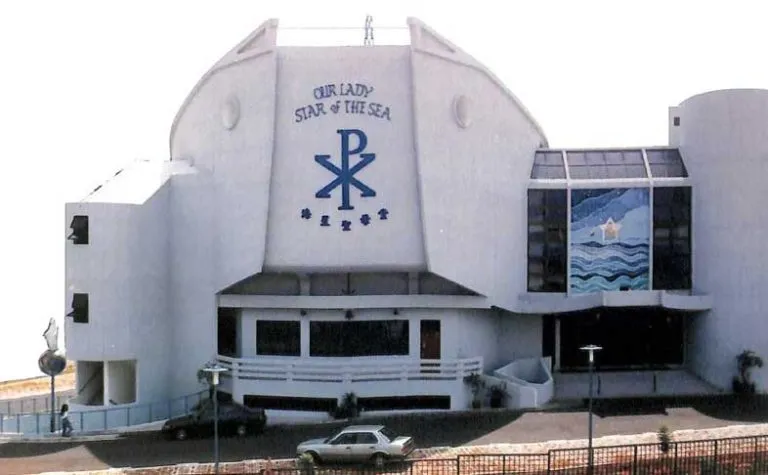
Introduction
The Church of Our Lady Star of the Sea is a Roman Catholic Church in Singapore and comes under the jurisdiction of the Archdiocese of Singapore.
The church had its beginnings in the Naval Base area, in August 1949. This is now the area around Sembawang Road. Religious services started at an old Japanese language school which was left over from World War II. The school was located in Jalan Kedai, off Canberra Road.
With a growing number of Catholics in Sembawang, the British Naval Base in Sembawang, which was opened in 1926, priests from the Church of Our Lady of Lourdes were given permission to extend their ministry to this fledgling community.
Church services then were conducted in a makeshift building with Sunday Masses held within the premises of the original Naval Base School. At the end of WWII, a building situated at the far end of Jalan Kedai, off Canberra Road, formerly used as a school during the Japanese Occupation, was handed over to the Catholic community for church services. There they stayed until 1949.
Fr. Dominic Vendargon, (Aug 29, 1909 – Aug 3, 2005) was appointed by the then Bishop of Malacca & Singapore, Bishop Michel Olçomendy, M.E.P. to formulate an autonomous parish for the Naval Base workers and residence in that area.
In August 1950, Fr. Vendargon was succeeded by Fr. Albert Fortier (Apr 24, 1911- Jan 13, 1998) who conducted everything, from Masses, marriages and all other rites, at the Japanese school.
History of Church of Our Lady Star of the Sea, Singapore
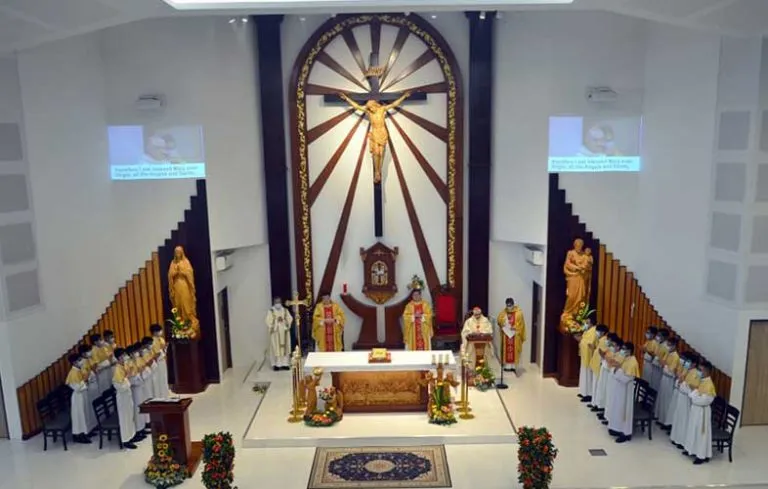
By 1952, the old school had become so rundown and unsafe that the British Colonial authorities advised Fr. Fortier to build a new church. Fr. Fortier found a plot of land in Jalan Sendudok which was part of the British Naval Base. The British Colonial authorities approved the site for a 21 year lease.
A new Church was dedicated on 13 December 1953, the 3rd Sunday in Advent, as the Church of Our Lady Star of the Sea by the Apostolic Delegate Monsignor Lucas. It cost a total of S$53,000.00. The parish house was added on in May 1954 after which Fr Fortier was transferred to the Church of Our Lady of Lourdes.
Fr. Fortier was succeeded by Fr. Innocent Fernandez for the next 10 years, followed by Fr. Bernard Binet from 1964 to 1968. Fr. Albert Fortier returned to assume the role of Parish Priest in July 1968 and stayed on till his retirement in 1986.
Fr. Amiotte-Suchet Louis (Aug 29, 1917- Oct 17, 1998) was appointed to take over from the duties of Fr. Fortier.
Due to the expansion of the neighborhood and land acquisition by the government, a new site for the church was needed. The present site at Yishun St 22 was chosen and built at a cost of $6.3 million, including land cost. It was declared open by Archbishop Gregory Yong on 30 May 1992 which was also the Sacerdotal Golden Jubilee of Fr Albert Fortier.
New and younger priests were posted in as Assistant Parish Priests to provide much needed relief for Fr Amiotte amd Fr Fortier.
On 13 Jan 1998, at the age of 86, Fr Fortier was called to be with the Lord.
Nine months later, on 17 Oct 1998, while on home leave in France, Fr Louis Amiotte-Suchet also passed away at the age of 81. He was succeeded in 1998 by Fr Peter Koh who was followed by Fr Edward Lim in Sept 2003. Upon his transfer to the Church of the Holy Trinity, Fr JJ Fenelon became the new Parish Priest of Our Lady Star of the Sea in Sep 2009.
Both Fr Fortier and Fr Amiotte worked hard over the years and lived to see the new church building officially opened. These two men have seen much action. Like true missionaries, they left everything behind, including home, family and country to serve the people of Singapore.
Together with their fellow missionaries and our local priests, they have worked tirelessly to make the Parish of Our Lady Star of the Sea a beacon of hope in the north for those seeking the Lord’s Kingdom.
Our Lady, Star of the Sea
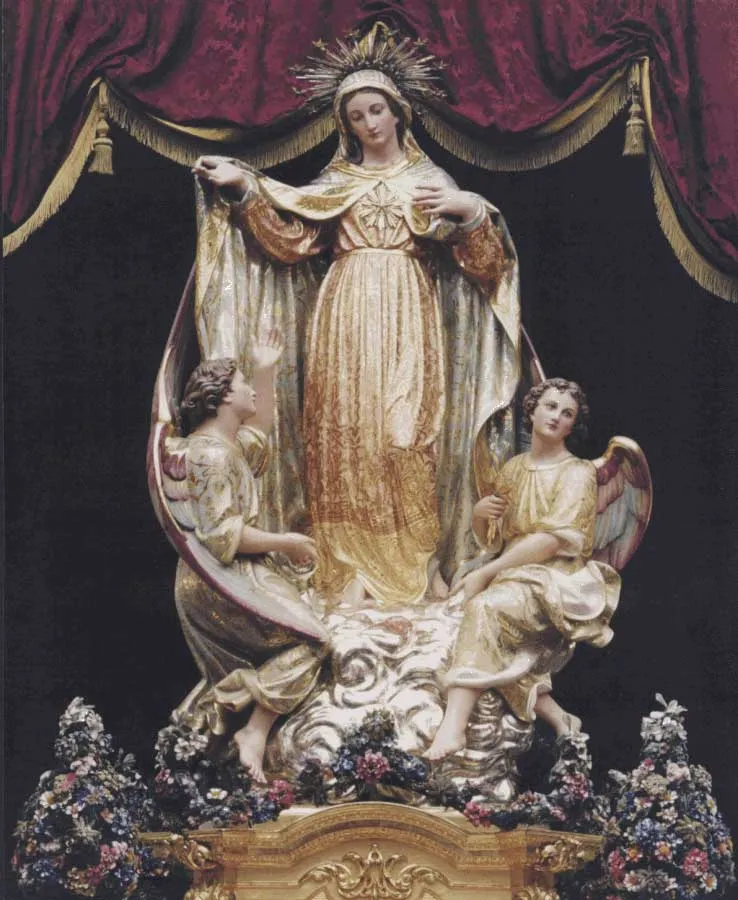
Our Lady, Star of the Sea is an ancient title for the Virgin Mary. The words Star of the Sea are a translation of the Latin title Stella Maris.
The title has been in use since at least the early medieval period. Purportedly arising from a scribal error in a supposed etymology of the name Mary, it came to be seen as allegorical of Mary’s role as “guiding star” on the way to Christ. Under this name, the Virgin Mary is believed to intercede as a guide and protector of seafarers in particular. The Apostleship of the Sea and many coastal churches are named Stella Maris or Star of the Sea.
Etymology and History of Our Lady, Star of the Sea
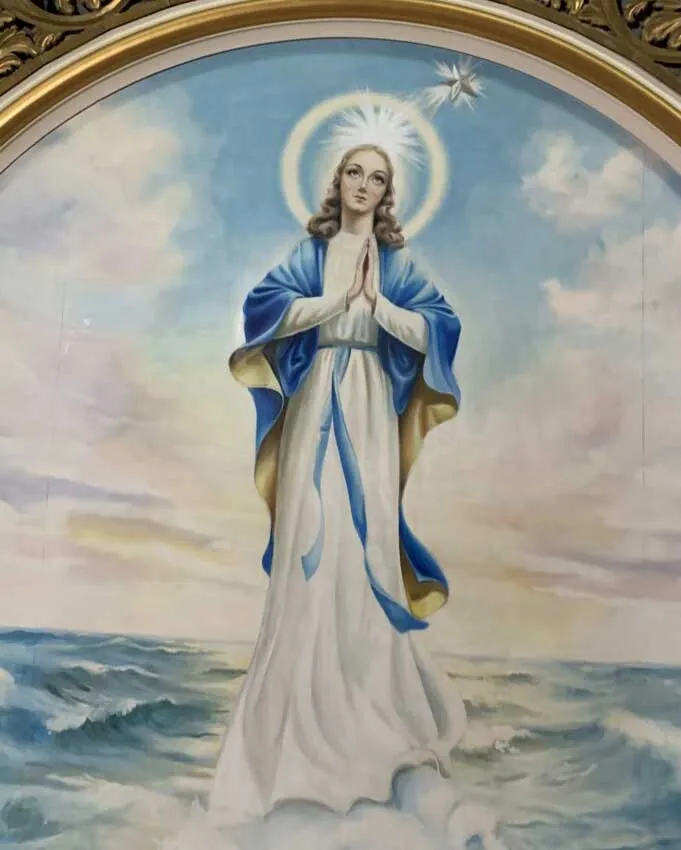
The name stella maris is first applied to the Virgin Mary in the manuscript tradition of Saint Jerome’s Latin translation of the Onomasticon by Eusebius of Caesarea, although this is in fact a misnomer based on a transcription error. For reaching this meaning the Hebrew name מרים (originally pronounced “Maryam”, but by Masoretic times pronounced “Miryam”) was first rendered into Greek as Mariam (Μαριάμ). It was this form that was etymologized by Eusebius. He interpreted Maryām as mar-yam (מר-ים) “drop of the sea”, based on מר mar, a rare biblical word for “drop”.
St. Jerome adopted this interpretation and translated the name into Latin as stilla maris, “drop of the sea”, but at some later stage a copyist transcribed this into stella maris, “star of the sea”, and this transcription error became widespread.
Another opinion states that Jerome himself interpreted the name as meaning “star of the sea” or Stella Maris, by relating it to a Hebrew word for star, מאור (ma’or), from the verb אור (‘or), to be light or shine.
The etymologization of the name of Mary as “star of the sea” was widespread by the early medieval period. It is referenced in Isidore’s Etymologiae (7th century). The plainsong hymn Ave Maris Stella (“Hail, Star of the Sea”) dates from about the 8th century. Paschasius Radbertus in the 9th century has an allegorical explanation of the name, writing that Mary is the “Star of the Sea” to be followed on the way to Christ, “lest we capsize amid the storm-tossed waves of the sea.”
In the medieval period, stella maris came to be used as a name of Polaris in its role as lodestar (guiding star, north star); it may have been used as such since Late Antiquity, as it is referred to as ἀειφανής “always visible” by Stobaeus in the 5th century, even though it was still some eight degrees removed from the celestial pole at that time.
In the twelfth century, Saint Bernard of Clairvaux wrote: “If the winds of temptation arise; if you are driven upon the rocks of tribulation look to the star, call on Mary. If you are tossed upon the waves of pride, of ambition, of envy, of rivalry, look to the star, call on Mary. Should anger, or avarice, or fleshly desire violently assail the frail vessel of your soul, look at the star, call upon Mary.”
Anthony of Padua also wrote of Mary as Star of the Sea.
Pope Pius XII, in his encyclical Doctor Mellifluus, also quoted Bernard of Clairvaux in saying: “Mary is interpreted to mean ‘Star of the Sea’. This admirably befits the Virgin Mother (for) as the ray does not diminish the brightness of the star, so neither did the Child born of her tarnish the beauty of Mary’s virginity.”
Stella maris was occasionally also used in reference to Christ. Robert Bellarmine deprecated this use of the title, preferring the allegory of Christ as the morning star as the “brightest star of all”, classing the less-bright polar star as “paltry” (exigua).

Devotional Application
The idea of Mary as a guiding star for seafarers has led to devotion to Our Lady, Star of the Sea in many Catholic coastal and fishing communities. Numerous churches, schools and colleges are dedicated to “Stella Maris, Our Lady Star of the Sea,” or “Mary, Star of the Sea.”
Stella Maris Monastery, the foundation house of the Carmelite order, was established on Mount Carmel in Haifa in the early thirteenth century. The abbey was destroyed several times, but a refounded Stella Maris monastery is still considered the headquarters of the order.
Devotions to this title of Mary are found in the popular Catholic hymn, Hail Queen of Heaven, the Ocean Star and the ancient prayer Ave Maris Stella. The widely sung “Sicilian Mariners Hymn”, O Sanctissima, also reflects this devotion.
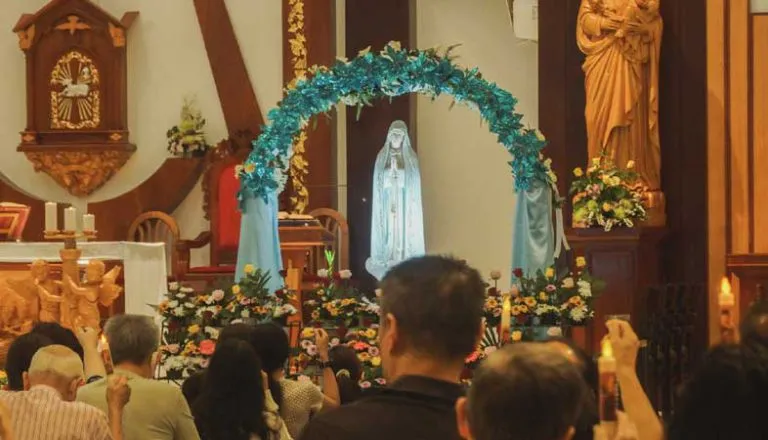
Seafarers
The Apostleship of the Sea (AOS) is often known locally as Stella Maris, whom seafarers recognise for providing pastoral, practical and spiritual support via their port chaplains and ship visitors in ports around the world. Our Lady Star of the Sea is the patron of the AOS.
The Apostleship of the Sea has for many years now, been commemorating the Feast of Stella Maris, Our Lady, Star of the Sea, with Mass each year in September for seafarers. It is a day to pray for all seafarers and give thanks for their contribution to global trade. The dates, times and venues of Stella Maris Masses for 2019 in England and Scotland can be found here. At a gathering during the Stella Maris Mass in Westminster Cathedral in 2016, Archbishop of Westminster Cardinal Vincent Nichols said, “Caring for seafarers is a profoundly Christian thing to do.”
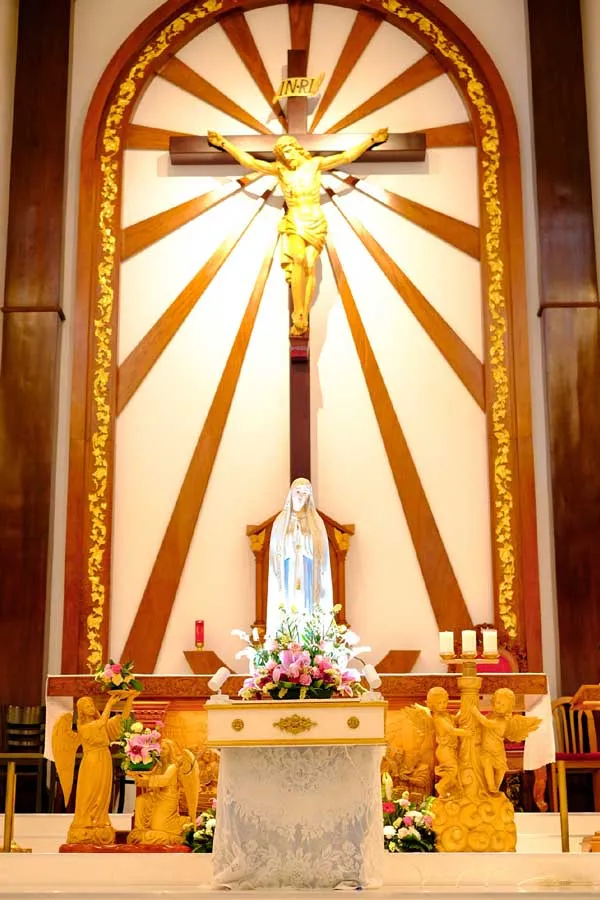
Feast Day - 25th September
The Annual Feast Day of Church of Our Lady Star of the Sea, on 25th September.
Mass Time
Weekdays
Saturdays
Sundays
Other Masses
Church Visiting Time
Contact Info
10 Yishun Street 22,
Singapore – 768579
Phone No.
Tel : +65 6257 4229
Accommodations
How to reach the Church
Singapore Changi Airport (SIN / WSSS) is the international airport in Singapore is nearby to the Church.
Yishun Subway Station in Singapore is the nearby Train Station to the Church.







